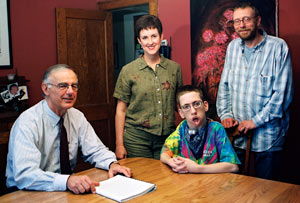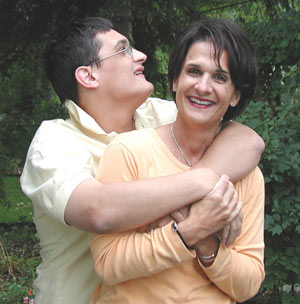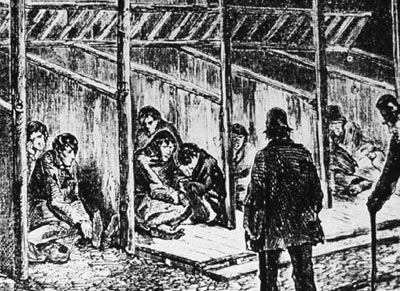The Minnesota Governor's Council on Developmental Disabilities
FORTY-FIVE YEARS OF HISTORY 1971-2016
This article, mainly covering 2002 – 2006, is the seventh of nine segments that will move the history along in five-year sections to bring the Council's work to the present. For context refer to this site's sections "Parallels in Time: A History of Developmental Disabilities" and "With an Eye to the Past" for laws, publications and other documents mentioned in text. In addition these documents were used extensively: 2002 -2006 Annual Reports and "Partners in Policymaking. Changing Lives. Changing Policies".
PARTNERS IN POLICYMAKING®:
In 2002, the Partners program began its fifteenth year. The Council's focus on leadership training for self advocates and parents of young children with developmental disabilities had demonstrated its success. Its strength is focusing on the big picture and creating a shared vision for the future, emphasizing eleven critical topics and twenty-five competencies that affect the way people with developmental disabilities are taught, employed, live and included in their communities. By offering participants the opportunity to meet and learn from national experts who present the latest thinking and research on specific topics, the training stays fresh, current and relevant.
Partners graduates:
- Become agents of long-term change.
- Become active partners with the policymakers whose decisions will shape their future.
- Dream about a future with possibilities
Partners continued to grow:
- In 2006, there were more than 15,000 Partners graduates nationally and internationally.
- Of that number, more than 670 were in Minnesota.
-
From 2002 to 2006, a total of 473 Minnesota Partners attended workshops to strengthen their leadership skills and training was offered on topics not covered in the classroom program.
CULTURAL OUTREACH PROGRAM:
The development of local leadership among culturally diverse parents of children with developmental disabilities was recognized as extremely important to creating inclusive, multicultural communities. The Council continued to support the cultural outreach program in the African American community, in the Native American community through 2003, in the Hispanic community through 2013, and in the Asian American community in 2004.
In both the Native American and Asian American programs, families built partnerships with elders in their communities and agencies were encouraged to support the training program. From 2002 – 2006, a total of 163 individuals graduated from the cultural outreach programs.
E-LEARNING COURSES:
As technology and Internet access increased among individuals with disabilities, online learning became a viable alternative for teaching and training purposes. The Council responded and began converting Partners to a series of e-learning classes for those who were not able to participate in the classroom program. The five self-directed online courses were made available at no cost to anyone interested in learning and understanding best practices in the area of developmental disabilities. Exams are included to test new knowledge and exercises give those taking the courses some practical skills.
2003: "Partners in Making Your Case"
The focus is on creating positive change through advocacy. Participants are helped to understand the legislative process, the essential elements of good advocacy, identify and research personal issues, and then advocate for systems change as individuals and as part of larger community efforts. The course includes opportunities to put what has been learned into practice through a series of interactive exercises.

2004: "Partners in Employment"
This course helps people with developmental disabilities find a job of their choice by learning how to plan their career; write a resume or portfolio of their strengths, skills, and interests; learn how to network and identify potential employers; prepare for an interview; and understand the hiring process. The course has been updated to include information on ways that people with autism and other developmental disabilities can find competitive, meaningful employment in the emerging "digital economy."

2005: "Partners in Education"
Parents of children with developmental disabilities are helped to understand and maximize the special education system. The course focuses on a child's right to a free appropriate public education, the laws that protect those rights, offers practical ways that parents can ensure that their children benefit from an inclusive education, and includes a review of IDEA 2004. Current thinking and the importance of teaching children digital technology to improve outcomes and prepare them for future employment opportunities are included.

2005: "Partners in Time"
This course is for individuals with developmental disabilities, their families, friends, educators and service providers. It gives the history of how people with disabilities have been treated from ancient times to the present. The focus is on the Disability Rights Movements beginning in the 1950s and how the efforts of advocates over the years have resulted in new legislation and new ways of thinking.

2006: "Partners in Living"
The concepts of self-determination, family support, community living and assistive technology are presented for people with developmental disabilities, their parents, family members and friends, educators and service providers. These four elements are explored to show how to create a meaningful life that is independent, inclusive, productive, self-determined and integrated.

ADDITIONAL COUNCIL ACTIVITIES:
In addition to its grant making and other activities, the Council continued to research studies:
- Public Opinion Poll to measure attitudinal changes of the general population in Minnesota during the past 45 years (based on a 1962 survey).
- Information Technology Insights focus groups to learn about the expectations of youth, with and without disabilities, regarding the use, accessibility, and future expectations of the use of technology.
- A nominations process to identify Minnesota businesses that are using innovative employment practices in hiring people with developmental disabilities and promoting an inclusive work environment.
- Information Technology Research Study to obtain measures about access to; and adoption, use and the perceived benefits of information technologies; satisfaction with state government websites; and attitudes about information technologies among people with disabilities compared with the general population in the state of Minnesota.
- Training and coaching on strategic planning and customer focus aligned to the Baldrige Criteria and Framework were also continued.
DIGITAL IMAGING/EMPLOYMENT:
Since 1988, the Council has worked to encourage employers to directly employ individuals with developmental disabilities. Individuals who received supported employment services were preparing the packets of resource materials for the Partners program.
In 2003, the Council piloted the scanning/document imaging project in an effort to explore this as a viable employment opportunity. Eighteen individuals were employed scanning approximately 28,600 pages of grant records, Partners in Policymaking records, and historical documents about Minnesota's deinstitutionalization efforts; and burning CD-ROMs for transfer to the GCDD's web site.
This demonstration project resulted in creating a resource package on how to replicate the digital imaging project that was shared with hundreds of agencies. A manual of seven training modules was produced, "Digital Imaging to Employ People with Developmental Disabilities." The manual included a scanning prep checklist, job coach responsibilities, and file labeling. As a result, 22 individuals with developmental disabilities were employed by two government agencies to scan records.

In 2006, the State of Minnesota received two awards from the International ComputerWorld Honors Program for the statewide Drive to Excellence government reform initiative.
One of these awards was presented to the Department of Human Services for its document imaging program.
Sixteen individuals with developmental disabilities worked on a project converting more than 3.5 million paper documents to electronic files. This project was the direct result of Council's successful document imaging pilot.

A video, "The Changing Face of Technology: Document Imaging Meets the Challenge," was produced in 2006. The video highlights five private sector businesses that decided to move to a more efficient and cost effective computerized records system and hired individuals with developmental disabilities to do the scanning/document imaging work.
More than 50 individuals were employed and earned at least minimum wage, and more than 56 million records were scanned.
Shamus O'Meara, Council Chair, together with US Senator Norm Coleman and US Representative Jim Ramstad, authored an article "Digital Partnering for People with Developmental Disabilities." Workshops were held where businesses were introduced to digital imaging procedures and encouraged to hire people with developmental disabilities for scanning and document imaging work.

In 2008, the State of Minnesota awarded contracts to seven businesses that agreed to employ people with developmental disabilities to perform scanning and document imaging work.
PUBLICATIONS:
"It's My Choice"
Published in March 2002, this workbook contains a series of guides, including an Individual Program Planning Guide, and checklists on housing, employment, and life in the community. The workbook can help individuals with developmental disabilities receive the services and supports they need to lead the lifestyle they prefer, be more independent, and actively participate in community life.
"Stories of Leadership"
In August 2002 the Council published this book of personal stories and photographs of 20 Partners in Policymaking graduates who talked about the impact of the Partners program on their lives. As with other Council publications this book elicited praise:
"This is the most beautiful, moving, and enjoyable piece that I have read in a long time. Thanks for another incredible publication."
RECAP:
An important addition to the Council web site was the release of Parallels in Time, Part 2 in October 2006 on the Council's 35th Anniversary. This portion of the history of disabilities covers the 1950 to 2006 time period, crossing into a new century. It explores a new way of thinking about home, learning, work and relationships, and how community services specifically can support people with developmental disabilities to obtain what is truly important to them:
- A home of my own
- Learning for life
- Real work for real pay
- Friendships and relationships
The new ways of thinking in 1987 were defined more broadly in 2006:
- HAVING A HOME, not just a roof over our heads
- LEARNING SKILLS WHICH ARE USEFUL IN OUR LIVES AND CAREERS, not just going to school
- WORKING, not just keeping busy
- DEVELOPING AND SUSTAINING RELATIONSHIPS, with people who depend on us and upon whom we can depend

"Forging a new reality with and for people with developmental disabilities… means focusing efforts on a single agenda – a meaningful life in the community – rather than continuing to maintain the dual systems of congregation/segregation and integration/inclusion."
The achievements of the Minnesota Governor's Council on Developmental Disabilities in its first 35 years (1971-2006) are impressive both nationally and internationally. The Council has been influential in state and federal legislation and policy implementation. The Council's publications, resource materials, and online courses have been accessed by individuals and organizations worldwide. The Partners in Policymaking leadership training program continues to grow both in the number of Partners graduates, and the impact of advocacy activities on the lives of individuals with developmental disabilities and their families.




